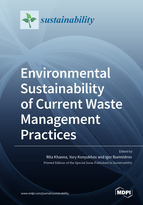Environmental Sustainability of Current Waste Management Practices
A special issue of Sustainability (ISSN 2071-1050). This special issue belongs to the section "Environmental Sustainability and Applications".
Deadline for manuscript submissions: closed (30 December 2021) | Viewed by 25112
Special Issue Editors
2. School of Materials Science and Engineering (Ret.), The University of New South Wales, Sydney, NSW 2052, Australia
Interests: waste management; resource recovery; environmental protection; sustainability; circular economy; metals and materials
Special Issues, Collections and Topics in MDPI journals
Interests: recycling of metallurgical wastes and mining tails; nanomaterials; structural and mechanical properties; high-temperature materials and processing; heavy-metal extraction from wastewater; magnetism studies
Special Issues, Collections and Topics in MDPI journals
Interests: renewable energy; thermo-electrochemical cells; nanomaterials; polymer composites; waste-water treatment
Special Issues, Collections and Topics in MDPI journals
Special Issue Information
Dear Colleagues,
This Special Issue will focus on recent developments in the field of ‘Waste Management’ including solid and liquid wastes, their collection, segregation, disposal, and processing in a cost-effective environmentally sustainable manner. Different types of wastes may include municipal, industrial, medical, construction, demolition, agricultural, electronic, hazardous, sewage sludge, etc. The focus will be on mitigating various environmental issues and on steps taken to enhance the sustainability of current procedures and practices around the globe. Theoretical, simulation, or experimental studies on waste generation, characterization, economics, life-cycle assessment, and environmental factors in various scenarios are also welcome as journal articles or reviews.
This Special Issue will be part of the section “Environmental Sustainability and Applications” of the journal Sustainability. We welcome the submission of high-quality research or review articles focusing on waste processing, recycling, material recovery, and the environmental impact of sustainable waste management. Specific topics include, but are not limited to the following:
- Novel technologies and upgrades;
- Environmental impacts;
- Economic factors;
- Waste regulations;
- Environmental policies;
- Resource recovery;
- Theoretical and experimental research;
- Other topics of interest in the field.
Prof. Dr. Rita Khanna
Prof. Dr. Yury Konyukhov
Prof. Dr. Igor Burmistrov
Guest Editors
Manuscript Submission Information
Manuscripts should be submitted online at www.mdpi.com by registering and logging in to this website. Once you are registered, click here to go to the submission form. Manuscripts can be submitted until the deadline. All submissions that pass pre-check are peer-reviewed. Accepted papers will be published continuously in the journal (as soon as accepted) and will be listed together on the special issue website. Research articles, review articles as well as short communications are invited. For planned papers, a title and short abstract (about 100 words) can be sent to the Editorial Office for announcement on this website.
Submitted manuscripts should not have been published previously, nor be under consideration for publication elsewhere (except conference proceedings papers). All manuscripts are thoroughly refereed through a single-blind peer-review process. A guide for authors and other relevant information for submission of manuscripts is available on the Instructions for Authors page. Sustainability is an international peer-reviewed open access semimonthly journal published by MDPI.
Please visit the Instructions for Authors page before submitting a manuscript. The Article Processing Charge (APC) for publication in this open access journal is 2400 CHF (Swiss Francs). Submitted papers should be well formatted and use good English. Authors may use MDPI's English editing service prior to publication or during author revisions.
Keywords
- municipal waste
- electronic waste
- industrial waste
- medical waste
- construction waste
- agricultural waste
- hazardous waste
- economic factors
- technology upgrades
- environmental impact
- sustainability
- landfilling
- urban mining
- developing countries







